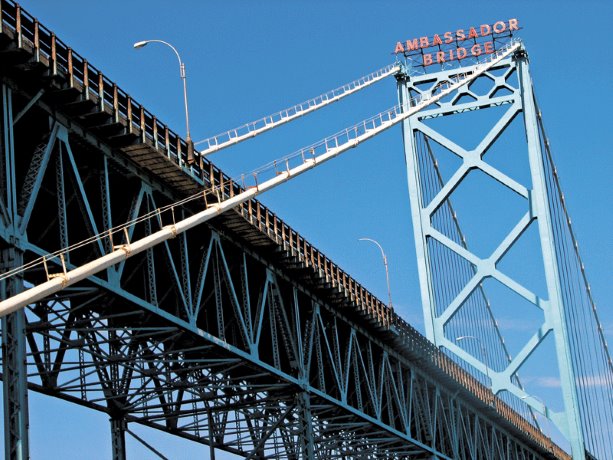Everyday up to 10,000 trucks use the Ambassador Bridge to cross the Detroit River between Windsor and Detroit. In 2015, more than a quarter of the $700 billion merchandise trade between Canada and the United States passed beneath the bridge’s massive towers and trademark signs.
The bridge is North America’s busiest border crossing in terms of trade volume. Strategic location drives its popularity, and back when the idea of building a bridge between the two cities was first discussed — well over a century ago — proponents recognized its potential to boost local economies.
That’s just the sort of justification governments use to move key infrastructure projects ahead. So perhaps what comes as the greatest surprise in the Ambassador Bridge’s eventful existence is that private business instead took the lead to build it.
Back in the Roaring Twenties when the bridge was built, Detroit was in the midst of a building frenzy. Many of the city’s landmark buildings, such as the Penobscot and General Motors buildings and the Henry Ford Museum, went up in the decade. The auto industry roared too and auto manufacturers hungrily eyed expansion into Ontario, an ideal jumping off point for Canadian and other British Commonwealth markets.
A 1924 meeting between John W. Austin, an officer of the Detroit Graphite company, and Joseph A. Bower, a financier (and one-time palm reader), sparked the project, according to the bridge’s official history and Philip Parker Mason’s 1987 book, The Ambassador Bridge: A Monument to Progress.
Austin had been involved in an earlier attempt to establish a bridge to serve cars, trains, streetcars and pedestrians. He’d set his sights on winning the painting contract for his company if the project went ahead. However, dubious sales and business practices employed by the project’s Canadian fundraiser helped ruin the venture before it even got off the ground.
Now, with Bower at the helm, effort began anew to connect the two cities. Bower bought up the stock options and assets of the Canadian and American Transit companies — formed during the previous unsuccessful venture — and worked ceaselessly for years to forge support at all levels of government on both sides of the border.
He and Austin, now the venture’s treasurer, also hired McClintic-Marshall Construction Company to engineer and build the bridge that would briefly become the world’s longest suspension bridge.
Headquartered in Pittsburgh, Pa. and formed in 1900, McClintic-Marshall was fast becoming the United States’ largest independent steel manufacturer. At the time it built the bridge, the company had plants in 10 locations across the country and several branch locations as well.
 Workers on the Ambassador Bridge project, crica 1928, compact separate cable strands into a finished cable. This compaction resulted in cables 19 inches in diameter. – Photo:SOUTHWESTERN ONTARIO DIGITAL ARCHIVE
Workers on the Ambassador Bridge project, crica 1928, compact separate cable strands into a finished cable. This compaction resulted in cables 19 inches in diameter. – Photo:SOUTHWESTERN ONTARIO DIGITAL ARCHIVEThe company’s contract called for it to assume all risks of construction and to supply everything that was needed from materials to build the structure to office furnishings. Bower and his partners sold mortgage bonds and debentures, raising $20 million to cover construction, property acquisition and all other expenses. The bridge’s developers planned to charge tolls to pay back investors.
Plans called for a structure that would extend a mile and three quarters between the terminals’ entrances, a roadway 47 feet wide over the bridge portion and an eight feet wide sidewalk. At its centre, the bridge would stand 152 feet above high water. The main bridge span would be 1,850 feet, a little over a third of a mile; two cables would carry the main span’s deck load.
Each of the cables, a McClintic-Marshall account of the bridge build says, "was laid up wire by wire, the reels being mounted at one anchorage and the wire unreeled and transported to place by mechanical means…After all the wires, comprising one cable, were in place they were squeezed, by a circular group of hydraulic jacks, into a compact cable of 19 inches diameter."
Anchored in masonry, the pressure from these cables transferred to bedrock 110 feet below the ground.
"The design and construction of the anchorages was the most perplexing feature of the project, because of the great depth to rock through wet clay and quicksand," the McClintic-Marshall account says. "The design had also to provide for an interruption when enough concrete should be in place to permit spinning of the cables to proceed."
Work began in May 1927 in Detroit. The project’s formal launch in Canada took place a month later. McClintic-Marshall faced hefty penalties if the project wasn’t complete by the target finish date of Aug. 16, 1930. But the firm’s contract also contained strong incentive for finishing early: half the bridge’s toll revenues from the earlier opening date to April 1930.
On Nov. 2, 1927, McClintic-Marshall sank the Canadian main pier caisson. By early August 1928 crews were towing footbridge ropes.
Construction continued rapidly, and the builders expected the span over the river would be done by February 1929, a year ahead of schedule.
Then came disaster.
 Construction on the Ambassador Bridge across the Detroit River officially began on May 7, 1927; it was built by the McClintic-Marshall Company (Pittsburgh) for the Detroit International Bridge Company and it opened to traffic on Nov. 15, 1929. Pictured here is the travelling wheel which pulls a wire from anchorage to anchorage, thus laying two wires at each trip. It took 218 wires to make one strand and 37 strands go to each cable. – Photo:SOUTHWESTERN ONTARIO DIGITAL ARCHIVE
Construction on the Ambassador Bridge across the Detroit River officially began on May 7, 1927; it was built by the McClintic-Marshall Company (Pittsburgh) for the Detroit International Bridge Company and it opened to traffic on Nov. 15, 1929. Pictured here is the travelling wheel which pulls a wire from anchorage to anchorage, thus laying two wires at each trip. It took 218 wires to make one strand and 37 strands go to each cable. – Photo:SOUTHWESTERN ONTARIO DIGITAL ARCHIVEThe engineers’ plans had called for heat treating the strands of wires that made up the 37 cables in each of the two main cables. The approach was new, and its proponents believed it created wire stronger than cold-drawn steel wire.
On Feb. 22, 1929, the builders learned three wires had snapped on another bridge being built by McClintic-Marshall in Rhode Island. Heat treatment had been applied to those wires too.
In Detroit and Windsor, work halted. McClintic-Marshall decided to replace all the cables with cold-drawn steel wire and absorb the $500,000 cost, the equivalent to more than US$7 million in today’s dollars.
Work resumed and, despite the setback, proceeded quickly. By Nov. 11, 1929, the bridge was complete. Four days later, it opened to traffic.
In all, the bridge cost $23.5 million to build.
Having opened less than a month after the 1929 stock market crash, the bridge operations struggled through the Great Depression of the 1930s. In 1931, only 500,000 vehicles had used the crossing, a volume far below the 4,000 touring cars per hour that it had been designed to handle.
By the late 1930s the Detroit International Bridge Company that owned and operated the bridge declared bankruptcy. Bower restructured, steering the company into public ownership and retaining a controlling share.
The Moroun family through its Central Cartage Company bought the bridge’s operating company in 1979, and the bridge returned to private hands. (Today, Forbes lists the Detroit family’s net worth at $1.5 billion and identifies transportation as the key source of its wealth.)
Yet once again, the bridge with the once groundbreaking span might be headed for hard times. The structure is no longer large enough to handle the burgeoning volume of truck traffic at this border. Plans for another bridge financed by the Canadian government are well underway.
Nevertheless, 88 years after it was built, the bridge that arches so gracefully across the great Detroit River remains the world’s longest international suspension bridge and a proud testament to 20th century advances in engineering.











Recent Comments
comments for this post are closed